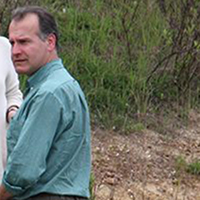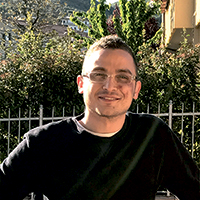 Angela Baldanza (corresponding author), Department of Physics and Geology, University of Perugia, Via A. Pascoli ‒ I-06123 Perugia, Italy, angela.baldanza@unipg.it
Angela Baldanza (corresponding author), Department of Physics and Geology, University of Perugia, Via A. Pascoli ‒ I-06123 Perugia, Italy, angela.baldanza@unipg.it
Research fields: Biostratigraphy (Calcareous Nannofossils and Foraminifera), Paleoecology and paleoenvironmental reconstruction of marine and continental successions (from Jurassic to Quaternary). Archeometry (characterization of raw and building materials from historical Greek, Roman, and Middle Age Italian sites). Conservation and enhancement of plant fossil record (Dunarobba Fossil Forest, Umbria, Italy). Member of SPI (Italian Society of Paleontology) and AIQUA (Italian Association for Quaternary researches). Scientific director of the Allerona Museum from 2015 onward.

R oberto Bizzarri, Department of Physics and Geology, University of Perugia, Via A. Pascoli ‒ I-06123 Perugia, Italy, roberto.bizzarri@libero.it
oberto Bizzarri, Department of Physics and Geology, University of Perugia, Via A. Pascoli ‒ I-06123 Perugia, Italy, roberto.bizzarri@libero.it
Degree (magna cum laude) in Geology in 2001, he received a Ph.D. in Earth Sciences (Stratigraphy and Sedimentology) in 2007 at the University of Perugia (Italy). He worked on projects for geological mapping 2004-2010. Research Fellow 2011-2012 and 2015-2016 at the University of Perugia. Currently collaborates as freelance researcher with the Department of Physics and Geology, University of Perugia, and alternates between research and the teaching of Natural Sciences in high school. His research interests include Sedimentology of marine and continental deposits, Quaternary Geology and Stratigraphy, Paleoenvironmental reconstruction and Paleoecology, Field Geology and Geological Mapping, Cultural Heritage and Scientific Dissemination.

 Federico Famiani, Paleontological Museum - Mount Subasio Regional Park, Loc. Cà Piombino - I-06081Assisi, Perugia, Italy. federico.famiani@gmail.com
Federico Famiani, Paleontological Museum - Mount Subasio Regional Park, Loc. Cà Piombino - I-06081Assisi, Perugia, Italy. federico.famiani@gmail.com
Coordinator and supervisor at Paleontological Museum of Mount Subasio Regional Park (Assisi, Umbria, Italy). Research fields: Paleoecology and paleoenvironmental reconstruction of marine successions in Umbria and Calabria Quaternary deposits.
Interests: GIS, Geological mapping, stratigraphy, Invertebrate Paleontology, Toarcian Ammonites and Quaternary. Member of SPI (Italian Paleontological society) and SGI (Italian Geological Society – deputy of young section).

 Alessandro Garassino, Natural History Museum, Paleontology Department, Corso Venezia 55 - I-20121 Milan, Italy. alegarassino@gmail.com
Alessandro Garassino, Natural History Museum, Paleontology Department, Corso Venezia 55 - I-20121 Milan, Italy. alegarassino@gmail.com
Curator of the Department of Invertebrate Palaeontology of the Natural History Museum of Milan since 1991. The activity is mainly based on four areas: research and study on Mesozoic and Cenozoic decapod crustaceans; arranging and cataloguing the fossil invertebrate collections; educational-scientific preparation of the paleontological exhibits; supervision of paleontological laboratory in the preparation of vertebrate and invertebrate specimens for the temporary and permanent exhibits.

 Giovanni Pasini, Via Alessandro Volta 16 - I-22070 Appiano Gentile (Como), Italy. juanaldopasini@tiscali.it
Giovanni Pasini, Via Alessandro Volta 16 - I-22070 Appiano Gentile (Como), Italy. juanaldopasini@tiscali.it
Retired teacher in Natural Sciences at lower secondary school. Volunteer representative with the Paleontological section of the MSNM, Milan - Italy. Experienced in field researchs and studies from Triassic to Cretaceous in Madagascar and Moroc. Researcher in Decapoda paleontology, systematics and behavior.

 Marco Cherin, Department of Physics and Geology, University of Perugia, Via A. Pascoli ‒ I-06123 Perugia, Italy, marco.cherin@unipg.it
Marco Cherin, Department of Physics and Geology, University of Perugia, Via A. Pascoli ‒ I-06123 Perugia, Italy, marco.cherin@unipg.it
Researcher in Vertebrate Paleontology at the Department of Physics and Geology, University of Perugia, Italy. He received his M.Sc. at the University of Pisa in 2009 with a dissertation on a fossil dolphin from the Early Pleistocene of southern Italy, and his Ph.D. at the University of Perugia in 2013 with a dissertation focused on the description of three new terrestrial mammal assemblages from the Pleistocene of central Italy. He currently works on the systematics, evolution, chronology, paleoecology and functional morphology of Neogene and Quaternary mammals. He also coordinates the Italian-Tanzanian research group on human evolution in the paleoanthropological sites of Olduvai Gorge and Laetoli (Tanzania).

F rancesco Rosatini, Via Strada di San Giacomo 1/D - I-06132 Fontignano (Perugia), Italy. f.rosatini@gmail.com
rancesco Rosatini, Via Strada di San Giacomo 1/D - I-06132 Fontignano (Perugia), Italy. f.rosatini@gmail.com
He studied at the University of Perugia, achieving the B.Sc. in Geology in 2012 (“Geodiversity: The memory of the Earth in the National Park of Mount Sibillini”), and the M.Sc. in Geological Sciences and Technologies in 2015 (“Benthic foraminifera, mollusk and ostracod assemblages close to evisceralites and cetacean carcasses in the Bargiano site (Allerona, TR): palaeoenvironmental and palaeoecological reconstruction”). Currently, he freely collaborates to research projects.

